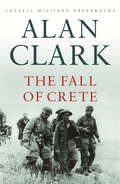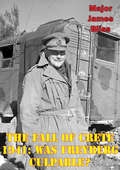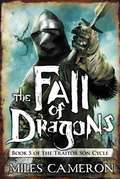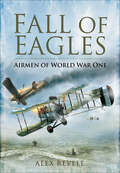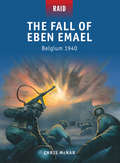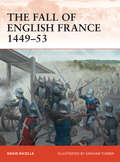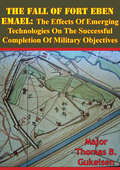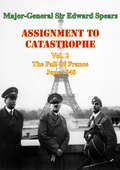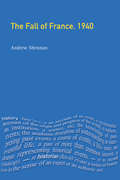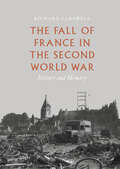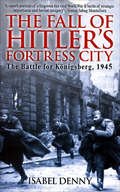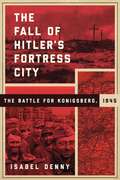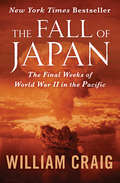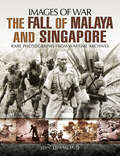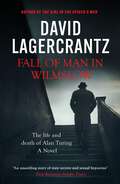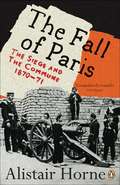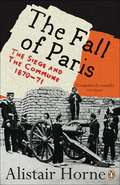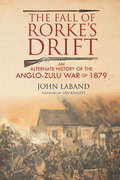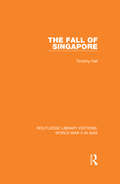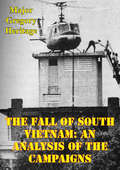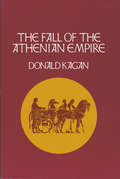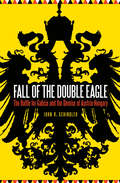- Table View
- List View
The Fall Of Crete
by Alan ClarkThe epic story of one of the most bitter and dramatic battles fought between German and Allied forces during the whole of the Second World War. The decisive action took place within five days, and twice its outcome hung in the balance. By the third day, the number of German dead exceeded their losses in all other theatres since the outbreak of hostilities. The German parachutists were confined for supply and reinforcements to a single airstrip at Maleme, yet on this one foothold they managed to land over eight thousand men, who defeated an Allied army nearly five times as numerous. With its vivid and compelling description of the battle for Crete, Clark confirmed his reputation as a military historian first recognised with The Donkeys, his account of the British Expeditionary Force in France in 1914.
The Fall Of Crete
by Alan ClarkThe epic story of one of the most bitter and dramatic battles fought between German and Allied forces during the whole of the Second World War. The decisive action took place within five days, and twice its outcome hung in the balance. By the third day, the number of German dead exceeded their losses in all other theatres since the outbreak of hostilities. The German parachutists were confined for supply and reinforcements to a single airstrip at Maleme, yet on this one foothold they managed to land over eight thousand men, who defeated an Allied army nearly five times as numerous. With its vivid and compelling description of the battle for Crete, Clark confirmed his reputation as a military historian first recognised with The Donkeys, his account of the British Expeditionary Force in France in 1914.
The Fall of Crete 1941: Was Freyberg Culpable?
by Major James BlissOn 20 May 1941, Generaloberst Kurt Student's Luftwaffe XI Fliegerkorps conducted the first operational airborne invasion in history to seize Crete. Major-General Bernard Cyril Freyberg VC, 2nd New Zealand Expeditionary Force, commanded the British forces defending the island. Freyberg, forewarned of the details of the invasion, possessed numerical superiority over the enemy, but was defeated within twelve days. Freyberg, later blamed for the defeat due to his perceived faulty defensive dispositions, was dealt a losing hand from the start. His troops consisted of those that could be rescued from the failed Greek Campaign and lacked sufficient weapons, communications, and transport to conduct the defense. Despite the best efforts of the Royal Navy, overwhelming Luftwaffe air superiority in the absence of the Royal Air Force isolated Crete and the relentless drive of the attacking German forces captured it. Poor tactical leadership by Freyberg's subordinate commanders and their failure to prosecute his operational plan led to defeat by the barest margin. While a tactical loss, Freyberg's destruction of the 7th Flieger Division resulted in Hitler never considering an operational airborne assault again. Freyberg, although accepting responsibility for the defeat, should not be held entirely culpable for the loss of Crete.
The Fall of Dragons (The Traitor Son Cycle #5)
by Miles CameronMiles Cameron is the master of intrigue and action-packed battles in this epic tale of magic and mercenaries, war, depravity, and politics, the final book of the Traitor Son Cycle.In the climax of the Traitor Son Cycle, the allied armies of the Wild and the Kingdoms of men and women must face Ash for control of the gates to the hermetical universe, and for control of their own destinies. But exhaustion, treachery and time may all prove deadlier enemies.In Alba, Queen Desiderata struggles to rebuild her kingdom wrecked by a year of civil war, even as the Autumn battles are fought in the west. In the Terra Antica, The Red Knight attempts to force his unwilling allies to finish the Necromancer instead of each other. But as the last battle nears, The Red Knight makes a horrifying discovery. . .all of this fighting may have happened before.
Fall of Eagles: Airmen of World War One
by Alex RevellThe Great War of 1914–1918 saw the rapid development of the airplane as a weapon of war. Initially its role was seen as that of reconnaissance, an extension of the cavalry, but as the war stagnated into static trench warfare, with each side facing each other across No Mans Land, the use of artillery, both in shelling enemy positions and counter-shelling his artillery, also became of prime importance. With the early development of radio communication between ground and air, airplanes also undertook the task of spotting for the artillery, and it soon became apparent that these airplanes both the reconnaissance machines and those working for the artillery could not be allowed to work unmolested, and fast fighter airplanes—both single and two seat began to make their appearance over the Western Front. Technical development was rapid. The mostly unarmed reconnaissance airplanes, and the early fighters of 1915 and 1916, armed with a single machine gun, had given way to fighters carrying two guns, flying at altitudes of over 16,000 feet and at treble the speed of the predecessors of 1914. With these developments a new type of soldier had evolved: the fighter pilot. Capable of fighting in the air, in three dimensions and at great speed, individual pilots began to emerge whose singular talents and temperament brought them to the forefront of their respective air forces. They became the aces, pilots who had brought down five or more of the enemy. Despite their expertise, few of these aces survived the war. The last combats of some are known and well documented, others are obscure. Some of the pilots in these pages are well-known, others less so, but all shared the common experience of fighting in the air during the war of 1914–1918: the conflict which saw the airplane evolve from a relatively fragile, unarmed reconnaissance machine, to a deadly weapon that changed the face of war for ever.
The Fall of Eben Emael - Belgium 1940
by Chris Mcnab Peter DennisIn early May 1940, the fortress of Eben Emael was a potent sentinel over the Belgian-Dutch borderlands. The fortress covered 75 hectares on the surface, had 5km of tunnels underground and was studded with bunkers, gun turrets and casemates. Add a garrison of 1,200 men and the natural protection of 60m-high canal walls, and Eben Emael gave the impression of near-impregnability. Yet on 10 May just 78 elite airborne soldiers managed to defeat this fortress in an operation of unprecedented tactical skill. Deployed by glider onto the very top of the fortifications, they utilized elite training, fast movement and specialist explosives to destroy many of the gun positions and trap much of the garrison within the fortress. Simultaneously, three other assault detachments conducted high-risk glider operations to capture critical bridges over the Albert Canal. By the end of 11 May, following the arrival of German infantry reinforcements, Eben Emael was in German hands. This Eben Emael RAID title tells the complete, fascinating story of this unique action.
The Fall of English France 1449-53
by David Nicolle Graham TurnerFor the overwhelming majority of people outside the French-speaking world the Hundred Years War consisted of a sequence of major English victories, above all Crécy, Poitiers and Agincourt. The only significant victor or 'hero' on the French side was Joan of Arc, and she ended up being burned at the stake. Yet somehow the war ended in a French victory and with England's martial energies being turned against itself in the Wars of the Roses. This book is intended to provide some balance. It will describe the campaign that brought the Hundred Years War to a close, with English possessions being confined to Calais and the Channel Islands. It will also explain how the somewhat unprepossessing and unmartial King Charles VII of France succeeded where his predecessors had failed. The campaign consisted of more than battles, of course, but it was marked by two major victories - at Formigny in 1450 and at Castillon in 1453. Formigny is of special interest because it saw French cavalry defeat English archers, in effect a reversal of Crécy, Poitiers and Agincourt, and could be interpreted as one of the last 'medieval' battles. Castillon is of interest because it was a victory of gunpowder artillery in fixed positions over a traditional medieval assault by mixed infantry and cavalry, and thus could be interpreted as one of the first 'modern' battles.
The Fall Of Fort Eben Emael: The Effects Of Emerging Technologies On The Successful Completion Of Military Objectives
by Major Thomas B. GukeisenThis study details the events of 10 May 1940 at Fort Eben Emael, Belgium, and the elements which led to the successful seizure of the fort by the German military. The central focus of this thesis is the following question: Was the use of emerging technologies the key to victory at Fort Eben Emael? First, the study focuses on the technologies themselves. Secondly, this study examines the leadership and training of the German unit assigned the mission at Fort Eben Emael. Lastly, this study examines administration and personnel issues that existed for the Belgians stationed at Fort Eben Emael. This study determined that the glider did afford troops the advantage of surprise; however, the hollow charge failed to live up to its reputation as it was most effective when used in such a way that it was no different than a conventional charge. Further, the German unit's training and leadership was exemplary and contributed more to the mission's success than the technologies the unit employed. Additionally, Fort Eben Emael was faced with serious internal issues that prevented a successful defence of the fort. Therefore, this thesis concludes that emerging technologies were not the most crucial component contributing to mission success.
The Fall Of France: June 1940 (Assignment To Catastrophe #2)
by Major-General Sir Edward Louis SpearsThe German victory in France at the onset of the Second World War was sudden, brutal and brilliant; by contrast the British and French preparations were miserable, faulty, badly carried through and fraught with mistrust. In the midst of these Allied responses was the eminent liaison officer Major-General Sir Edward Louis Spears, sent by the new prime Minister Winston Churchill to be his representative to the French Prime Minister. Spears was very well suited to his role as he had seen much military service and he had served in a senior liaison capacity between the British and French armies during the First World War. Keenly observant, well connected, urbane and respected by many of the French politicians and generals, his two volume memoirs are justly famous.
The Fall of France 1940
by Andrew ShennanOffering a fresh critical perspective on this momentous event, Andrew Shennan examines both the continuities and discontinuities that resulted from the events of 1940. The main focus is on the French experience of the war, but this experience is framed within the larger context of France's - and Europe's - protracted mid-twentieth century crisis.
The Fall of France in the Second World War: History and Memory
by Richard CarswellThis book examines how the fall of France in the Second World War has been recorded by historians and remembered within society. It argues that explanations of the fall have usually revolved around the four main themes of decadence, failure, constraint and contingency. It shows that the dominant explanation claimed for many years that the fall was the inevitable consequence of a society grown rotten in the inter-war period. This view has been largely replaced among academic historians by a consensus which distinguishes between the military defeat and the political demise of the Third Republic. It emphasizes the contingent factors that led to the military defeat. At the same time it seeks to understand the constraints within which France’s policy-makers were required to act and the reasons for their policy-making failures in economics, defence and diplomacy.
Fall of Hitler's Fortress City: The Battle for Knigsberg 1945
by Isabel Denny“A superb portrait of a forgotten but vital World War II battle of strategic importance and bestial savagery” (Simon Sebag Montefiore, New York Times–bestselling author of The Romanovs)Through firsthand accounts, as well as archival material, The Fall of Hitler’s Fortress City tells the dramatic story of the place and people that bore the brunt of Russia’s vengeance against the Nazi regime.In 1945, in the face of the advancing Red Army, two and a half million people were forced out of Germany’s most easterly province, East Prussia, and in particular its capital, Königsberg. Their flight was a direct result of Hitler’s ill-fated decision to invade the Soviet Union in 1941.The Russians launched Operation Bagration in June 1944, to coincide with the D-Day landings. As US and British forces pushed west, the Russians liberated Eastern Europe and made their first attacks on German soil in the autumn of 1944. Königsberg itself was badly damaged by two British air raids at the end of August 1944, and the main offensive against the city by the Red Army began in January 1945. The depleted and poorly armed German army could do little to hold it back, and by the end of January, East Prussia was cut off. The Russians exacted a terrible revenge on the civilian population, who were forced to flee across the freezing Baltic coast in an attempt to escape. On April 9, the city surrendered to the Russians after a four-day onslaught.“Denny fills in a gap in the historiography of World War II’s European eastern front.” —Booklist
The Fall of Hitler's Fortress City: The Battle for Konigsberg, 1945
by Isabel Denny Dennis ShowalterThe harrowing, tragic story of a city and a people ravaged by one of the most brutal battles of World War II.In 1945, in the face of the advancing Red Army, two and a half million people were forced out of Germany’s most easterly province, East Prussia, and in particular its capital, Königsberg. Their flight was a direct result of Hitler’s ill-fated decision to invade the Soviet Union in 1941. Now that the Germans were in retreat, the horrors of Leningrad and Stalingrad were to be avenged by an army determined not only to invade Germany but to take over its eastern territories.The Russians launched Operation Bagration in June 1944 to coincide with the D-Day landings. As US and British forces pushed west, the Russians liberated Eastern Europe and made their first attacks on German soil in the autumn of 1944. Königsberg itself was badly damaged by two British air raids at the end of August 1944, and the main offensive against the city by the Red Army began in January 1945. The depleted and poorly armed German army could do little to hold it back, and by the end of January, East Prussia was cut off. The Russians exacted a terrible revenge on the civilian population, who were forced to flee across the freezing Baltic coast in an attempt to escape. On April 9, the city surrendered to the Russians after a four-day onslaught.Through firsthand accounts as well as archival material, The Fall of Hitler’s Fortress City tells the dramatic story of a place and its people that bore the brunt of Russia’s vengeance against the Nazi regime.Skyhorse Publishing, as well as our Arcade imprint, are proud to publish a broad range of books for readers interested in history--books about World War II, the Third Reich, Hitler and his henchmen, the JFK assassination, conspiracies, the American Civil War, the American Revolution, gladiators, Vikings, ancient Rome, medieval times, the old West, and much more. While not every title we publish becomes a New York Times bestseller or a national bestseller, we are committed to books on subjects that are sometimes overlooked and to authors whose work might not otherwise find a home.
The Fall of Japan: The Final Weeks of World War II in the Pacific
by William CraigTold from both Japanese and American perspectives, this thrilling account of the final weeks of World War II in the Pacific has been heralded by the New York Times Book Review as "virtually faultless" By midsummer 1945, Japan had long since lost the war in the Pacific. The people were not told the truth, and neither was the emperor. Japanese generals, admirals, and statesmen knew, but only a handful of leaders were willing to accept defeat. Most were bent on fighting the Allies until the last Japanese soldier died and the last city burned to the ground. Exhaustively researched and vividly told, The Fall of Japan masterfully chronicles the dramatic events that brought an end to the Pacific War and forced a once-mighty military nation to surrender unconditionally. From the ferocious fighting on Okinawa to the all-but-impossible mission to drop the 2nd atom bomb, and from Franklin D. Roosevelt's White House to the Tokyo bunker where tearful Japanese leaders first told the emperor the truth, William Craig captures the pivotal events of the war with spellbinding authority. The Fall of Japan brings to life both celebrated and lesser-known historical figures, including Admiral Takijiro Onishi, the brash commander who drew up the Yamamoto plan for the attack on Pearl Harbor and inspired the death cult of kamikaze pilots., This astonishing account ranks alongside Cornelius Ryan's The Longest Day and John Toland's The Rising Sun as a masterpiece of World War II history.
The Fall of Malaya and Singapore: Rare Photographs From Wartime Archives (Images of War)
by Jon DiamondIn just 10 weeks from 8 December 1941 to mid February 1942, British and Imperial forces were utterly defeated by the numerically inferior Japanese under General Yamashita.British units fought hard on the Malayan mainland but the Japanese showed greater mobility, cunning and tactical superiority. Morale was badly affected by the loss of HMS Prince of Wales and Repulse to Japanese aircraft on 19 December as they sought out enemy shipping. Panic set in as military and civilians withdrew south to Singapore. Thought to be an impregnable fortress, its defences against land attacks were shockingly deficient. General Percival's leadership was at best uninspired and at worst incompetent.Once the Allied troops withdrew to Singapore it was only a matter of time before surrender became inevitable. To make matters worse reinforcements arrived but only in time to be made POWs.The whole catastrophe is brilliantly described in this highly illustrated book.
Fall of Man in Wilmslow
by David LagercrantzJune 8, 1954. Alan Turing, the visionary mathematician, is found dead at his home in sleepy Wilmslow, dispatched by a poisoned apple. Taking the case, Detective Constable Leonard Corell quickly learns Turing is a convicted homosexual. Confident it's a suicide, he is nonetheless confounded by official secrecy over Turing's war record. What is more, Turing's sexuality appears to be causing alarm among the intelligence services - could he have been blackmailed by Soviet spies? Stumbling across evidence of Turing's genius, and sensing an escape from a narrow life, Corell soon becomes captivated by Turing's brilliant and revolutionary work, and begins to dig deeper. But in the paranoid, febrile atmosphere of the Cold War, loose cannons cannot be tolerated. As his innocent curiosity fast takes him far out of his depth, Corell realises he has much to learn about the dangers of forbidden knowledge.
The Fall of Paris: The Siege and the Commune 1870-71
by Alistair HorneAlistair Horne's The Fall of Paris: The Siege and the Commune, 1870-71 is the first book of Alistair Horne's trilogy, which includes The Price of Glory and To Lose a Battle and tells the story of the great crises of the rivalry between France and Germany. The collapse of France in 1870 had an overwhelming impact - on Paris, on France and on the rest of the world. People everywhere saw Paris as the centre of Europe and the hub of culture, fashion and invention. But suddenly France, not least to the disbelief of her own citizens, was gripped in the vice of the Prussian armies and forced to surrender on humiliating terms. Almost immediately Paris was convulsed by the savage self-destruction of the newly formed Socialist government, the Commune. In this brilliant study of the Siege of Paris and its aftermath, Alistair Horne researches first-hand accounts left by official observers, private diarists and letter-writers to evoke the high drama of those ten tumultuous months and the spiritual and physical agony that Paris and the Parisians suffered as they lost the Franco-Prussian war.
The Fall of Paris: The Siege and the Commune 1870-71
by Alistair HorneThe collapse of France in 1870 had an overwhelming impact – on Paris, on France and on the rest of the world. People everywhere saw Paris as the centre of Europe and the hub of culture, fashion and invention. Suddenly France, not least to the disbelief of her own citizens, was gripped in the vice of the Iron Chancellor’s armies and forced to surrender on humiliating terms. In this brilliant study of the Siege and its aftermath, Alistair Horne evokes the high drama of those ten fantastic months and the spiritual agony which Paris and the Parisians suffered.The Fall of Paris is the first part of the trilogy including To Lose a Battle and The Price of Glory (already available in Penguin).
The Fall of Rorke's Drift: An Alternate History of the Anglo-Zulu War of 1879
by John LabandFor fans of Harry Turtledove, an alternate history novel in which Zulu forces triumph over the British at Rorke&’s Drift in 1879 and invade Natal. January 1879. The British Empire and the Zulu Kingdom are at war. Lord Carnarvon, Secretary of State for the Colonies, who had successfully brought about federation in Canada in 1867, had believed a similar scheme would work in South Africa. But such plans are rejected by Boer leaders. Lord Chelmsford leads a British military expeditionary force to enter the Zulu Kingdom uninvited. A bloody battle ensues on 22 January 1879 at Isandlwana. The Zulus are the unexpected victors. After that brutal defeat, the British Army are at Rorke&’s Drift on the Buffalo River in Natal Province, South Africa. A few hundred British and colonial troops, led by Lieutenants John Chard of the Royal Engineers and Gonville Bromhead, face the might of the Zulu army of thousands led by Prince Dabulamanzi kaMpande (CORR). Against the odds, the British are victorious, and this defeat marks the end of the Zulu nation&’s dominance of the region. The Defence of Rorke&’s Drift would go down in history as an iconic British Empire Battle and inspired Victorian Britain. Eleven Victoria Crosses were awarded to military personnel. But what if the Zulus had defeated the British at Rorke&’s Drift and invaded Natal? . . . In the first ever alternate history of the Anglo-Zulu War, historian John Laband asks that question. With his vast knowledge of the Anglo-Zulu War, he turns history on its head and offers a tantalizing glimpse of a very different outcome, weaving a compelling, never-before told story of what could have been.
The Fall of Rorke's Drift: An Alternate History of the Anglo-Zulu War of 1879
by John LabandFor fans of Harry Turtledove, an alternate history novel in which Zulu forces triumph over the British at Rorke&’s Drift in 1879 and invade Natal. January 1879. The British Empire and the Zulu Kingdom are at war. Lord Carnarvon, Secretary of State for the Colonies, who had successfully brought about federation in Canada in 1867, had believed a similar scheme would work in South Africa. But such plans are rejected by Boer leaders. Lord Chelmsford leads a British military expeditionary force to enter the Zulu Kingdom uninvited. A bloody battle ensues on 22 January 1879 at Isandlwana. The Zulus are the unexpected victors. After that brutal defeat, the British Army are at Rorke&’s Drift on the Buffalo River in Natal Province, South Africa. A few hundred British and colonial troops, led by Lieutenants John Chard of the Royal Engineers and Gonville Bromhead, face the might of the Zulu army of thousands led by Prince Dabulamanzi kaMpande (CORR). Against the odds, the British are victorious, and this defeat marks the end of the Zulu nation&’s dominance of the region. The Defence of Rorke&’s Drift would go down in history as an iconic British Empire Battle and inspired Victorian Britain. Eleven Victoria Crosses were awarded to military personnel. But what if the Zulus had defeated the British at Rorke&’s Drift and invaded Natal? . . . In the first ever alternate history of the Anglo-Zulu War, historian John Laband asks that question. With his vast knowledge of the Anglo-Zulu War, he turns history on its head and offers a tantalizing glimpse of a very different outcome, weaving a compelling, never-before told story of what could have been.
The Fall of Singapore 1942 (Routledge Library Editions: World War II in Asia)
by Timothy HallSingapore fell to the Japanese on 15 September 1942, but in 1941 Europeans on the island felt still untouched by war, lulled into security by the belief that Singapore was impregnable from the sea. However, the Planning Chief of Imperial Army Headquarters in Tokyo had realised a successful invasion could come from the north, down the Malay peninsula... Requests from less naive members of the allied forces for more men, arms and equipment were not filled. Authorities were unwilling to reveal to the civilian population the true situation. And so through accident or miscalculation, Singapore was totally unable to repel the Japanese attack. This accessible book, illustrated with black and white photos charts the course of these events.
The Fall Of South Vietnam: An Analysis Of The Campaigns
by Major Gregory HeritageThis monograph addresses what operational level military factors enabled the North Vietnamese Army to defeat the former South Vietnamese Army during the Vietnam War's final campaigns of 1975. The Vietnam War covered the full spectrum of conflict from terrorism, to guerrilla warfare, to a conventional war of maneuver. The final North Vietnamese offensive that defeated the South Vietnamese Army were conventional campaigns that provide opportunities for operational level planners to learn from the Vietnam experience.The methodology followed in the monograph involves first establishing a basis of information on the strategic situation and the final campaigns, and then analyzing the campaigns with Cohen and Gooch's model of military misfortune.The communists began their final offensive campaigns in December, 1974 by seizing Phuoc Long Province. In March, 1975, they continued their offensive campaigns by conducting diversionary attacks in the north threatening Pleiku and then attacking the lightly defended South Vietnamese rear area. The Communists quickly captured the Central Highlands and then raced to the sea to divide the South Vietnamese Army (ARVN). The communists blocked the South Vietnamese attempt to retrograde from the Central Highlands and destroyed the ARVN II Corps. The communists then concentrated combat power to destroy the South Vietnamese six divisions isolated in the north. After destroying these divisions, the communist seized Saigon which ended the war.The South Vietnamese suffered a catastrophic failure and lost the war because of their inability to learn, anticipate, and adapt. The South Vietnamese, failing to learn the basics of operational art, tried to defend the entire country through corps area defenses. Thus, they never defended in depth or concentrated combat power to defeat their adversary's main effort.
The Fall Of Terok Nor: Millennium (Star Trek: Deep Space Nine #Vol. 1)
by Judith Reeves-StevensContinuing the Deep Space Nine saga—an original novel from New York Times bestselling author Judith Reeves-Stevens!Bajor is in flames. The corridors of Terok Nor echo with the sounds of battle. It is the end of the Cardassian Occupation -- and the beginning of the greatest epic adventure in the saga of Deep Space 9™ Six years later, with the Federation losing ground in its war against the Dominion, the galaxy's greatest smugglers—including the beautiful and enigmatic Vash—rendezvous on Deep Space 9. Their objective: a fabled lost Orb of the Prophets unlike any other, rumored to be the key to unlocking a second wormhole in Bajoran space—a second Celestial Temple. Almost immediately, mysterious events plague the station: Odo arrest Quark for murder; Jake and Nog lead Chief O'brien to an eerie holosuite in a section of the station that's not on any schematic; and a Cardassian scientist whom even the Obsidian Order once feared makes an unexpected appearance. With all those events tied to a never-before-told story of the Cardassian withdrawal, Captain Benjamin Sisko faces the most dangerous challenge of his career. Unless he can uncover the secret of the lost Orb, what began with the fall of Terok Nor will end with the destruction of Deep Space 9...or worse.
The Fall of the Athenian Empire (A New History of the Peloponnesian War)
by Donald KaganIn the fourth and final volume of his magisterial history of the Peloponnesian War, Donald Kagan examines the period from the destruction of Athens' Sicilian expedition in September of 413 B.C. to the Athenian surrender to Sparta in the spring of 404 B.C. Through his study of this last decade of the war, Kagan evaluates the performance of the Athenian democracy as it faced its most serious challenge. At the same time, Kagan assesses Thucydides' interpretation of the reasons for Athens' defeat and the destruction of the Athenian Empire.
Fall of the Double Eagle: The Battle for Galicia and the Demise of Austria-Hungary
by John R. SchindlerAlthough southern Poland and western Ukraine are not often thought of in terms of decisive battles in World War I, the impulses that precipitated the battle for Galicia in August 1914—and the unprecedented carnage that resulted—effectively doomed the Austro-Hungarian Empire just six weeks into the war.In Fall of the Double Eagle, John R. Schindler explains how Austria-Hungary, despite military weakness and the foreseeable ill consequences, consciously chose war in that fateful summer of 1914. Through close examination of the Austro-Hungarian military, especially its elite general staff, Schindler shows how even a war that Vienna would likely lose appeared preferable to the “foul peace” the senior generals loathed. After Serbia outgunned the polyglot empire in a humiliating defeat, and the offensive into Russian Poland ended in the massacre of more than four hundred thousand Austro-Hungarians in just three weeks, the empire never recovered. While Austria-Hungary’s ultimate defeat and dissolution were postponed until the autumn of 1918, the late summer of 1914 on the plains and hills of Galicia sealed its fate.
